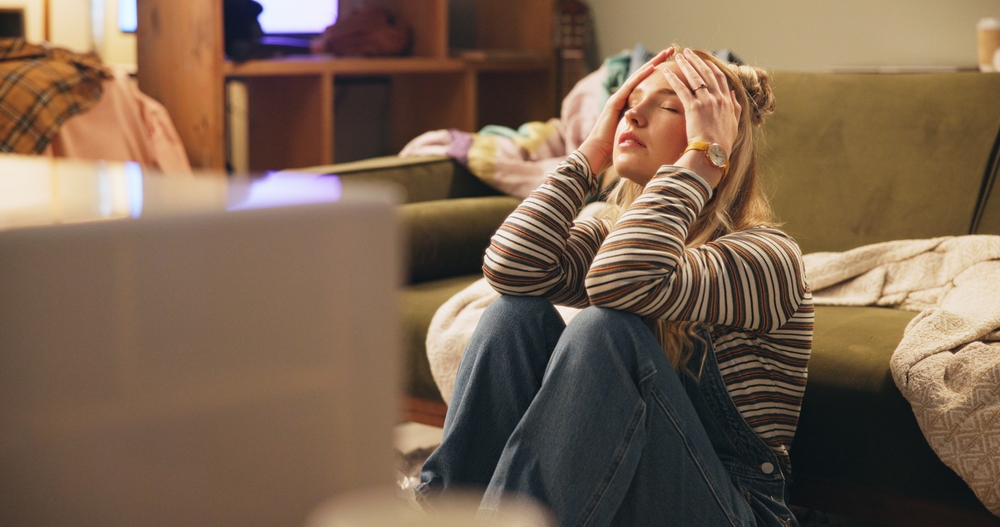
Ever walked into a room and instantly felt uneasy, even if you couldn’t put your finger on why? Maybe your living room feels chaotic no matter how often you clean, or your bedroom never quite feels restful. You might blame clutter, bad lighting, or even your roommate’s questionable décor taste—but psychologists say there’s something deeper going on. Certain design choices actually trigger stress on a subconscious level, making your home feel more like a pressure cooker than a sanctuary.
So before you repaint, rearrange, or redecorate, let’s dive into the sneaky interior design habits that could be quietly turning your home into a source of daily tension.
1. Cluttered Surfaces and Overcrowded Rooms
We all know clutter is bad news, but psychologists have found that visual overload actually spikes cortisol—the stress hormone—every time we walk into a messy space. A countertop covered with mail, receipts, keys, and half-empty mugs signals unfinished tasks to the brain, keeping you in a low-level state of alertness. It’s not just about aesthetics—it’s about mental breathing room. Even organized clutter, like shelves stuffed with trinkets, can make your brain work overtime. Minimal doesn’t mean sterile; it just means giving your mind some space to exhale.

2. Harsh Lighting That Feels More Like an Office Than a Home
Lighting affects mood far more than most people realize. Cold, white fluorescent bulbs mimic workplace environments and can make you feel tense even after hours. On the flip side, spaces that are too dim can leave you feeling sluggish or trapped. Psychologists say the healthiest lighting mimics natural daylight during the day and softens into warmer tones at night. So if your home feels like a corporate cubicle or a dim cave, a few lighting tweaks could dramatically change your emotional atmosphere.
3. Clashing Colors That Confuse the Brain
Color psychology isn’t just design fluff—it’s neuroscience in action. Bright red dining rooms or neon-accented bedrooms might look daring on Pinterest, but in real life, they can overstimulate your senses and elevate heart rate. Too many clashing colors can also create a sense of chaos, even if the space is clean. Calm tones like blues, greens, and muted neutrals are easier on the eyes and the nervous system. When in doubt, think harmony over drama—your brain will thank you.
4. Too Much Open Space with No Boundaries
Open-concept living is trendy, but psychologists say it can come with unexpected stressors. Without defined zones for relaxation, work, and dining, your brain struggles to switch gears. That lack of separation can lead to blurred boundaries and constant background tension. Suddenly, you’re eating breakfast where you work, lounging where you argue, and sleeping with no sense of privacy. Strategic furniture placement or area rugs can help create mental “zones” that bring order to the openness.
5. Excessive Noise and Echo-Prone Rooms
You might not think about acoustics when decorating, but psychologists do. Hard floors, bare walls, and sparse furnishings can make sound bounce around like a pinball, subtly raising stress levels. Noise pollution—even low-level background hums—can lead to irritability and fatigue over time. Adding soft textures like rugs, curtains, and upholstered furniture helps absorb sound and create a sense of calm. The quieter your environment, the easier it is for your body to truly relax.
6. Unbalanced Layouts That Feel “Off”
Ever walk into a room that just feels awkward, even if everything’s clean and new? That’s often because of poor spatial balance. When furniture is too large for the space, or shoved awkwardly against walls, the room subconsciously feels unstable. Psychologists say symmetry and flow help the brain feel grounded and safe. So before you buy another accent chair, consider whether your space feels intuitively balanced—not just stylish on Instagram.
7. Neglecting Nature or Natural Elements
Humans are hardwired to respond positively to nature, yet many homes feel sealed off from it. Lack of plants, natural light, or organic textures can make your environment feel sterile and lifeless. Psychologists have long championed the “biophilic effect,” which says that incorporating nature—like greenery, wood, or even natural patterns—reduces anxiety and promotes happiness. A single leafy plant or wooden accent can shift the entire mood of a room. The closer your space mimics the calm of the outdoors, the better your body responds.
8. Overly Trendy or Impersonal Décor
That influencer-inspired aesthetic might look sleek, but psychologists warn it can disconnect you from emotional comfort. When your home feels more like a showroom than a personal refuge, it subtly communicates perfectionism and pressure. People often feel anxious in spaces that look good but lack personal warmth—photos, souvenirs, or items with sentimental value. Your home should tell your story, not mimic someone else’s highlight reel. Real comfort comes from authenticity, not algorithm-approved trends.
9. Too Many Screens and Tech Devices in Living Spaces
We live in a world of constant digital noise, and bringing that into your home amplifies it. TVs in bedrooms, laptops on coffee tables, and phones charging in every corner keep your brain wired and unable to unwind. Psychologists note that even inactive screens can increase mental stimulation simply by being visible. Creating screen-free zones signals to your brain that it’s time to relax, not respond. Sometimes peace of mind starts with unplugging—literally.
10. Neglecting the Power of Scent and Air Quality
You might not see it, but your nose notices it. Stale air, harsh cleaning product smells, or too many scented candles can trigger stress responses in ways you don’t consciously realize. Psychologists often point out that scent is directly tied to the emotional centers of the brain, which means your home’s smell can influence your mood instantly. Fresh air, subtle natural scents, or even an open window can lower tension dramatically. Think of air quality as invisible décor—it sets the tone more than you think.
Redesign Your Space, Redesign Your Stress Levels
Your home should feel like a retreat, not a trigger. The design choices we make every day—lighting, color, layout, clutter—have a direct impact on our emotions, energy, and relationships. The good news? You don’t need a full renovation to fix it. Small, mindful changes can make a huge difference in how peaceful your home feels and how calmly you move through it.
Have you noticed certain design choices that stress you out or help you unwind? Share your thoughts, stories, or design wins in the comments below.
You May Also Like…
Could Financial Aid Letters Be Designed to Confuse Students on Purpose
10 Design Choices That Lower Appraised Value Instantly
6 Times Group Saving Challenges Left Women in Actual Stress
Are You Preparing Your Child for Success or Stress? 7 Ways to Tell
Creative Ways to Sell Your House Fast Without the Stress
The post 10 Design Choices That Psychologists Say Trigger Domestic Stress appeared first on Everybody Loves Your Money.







